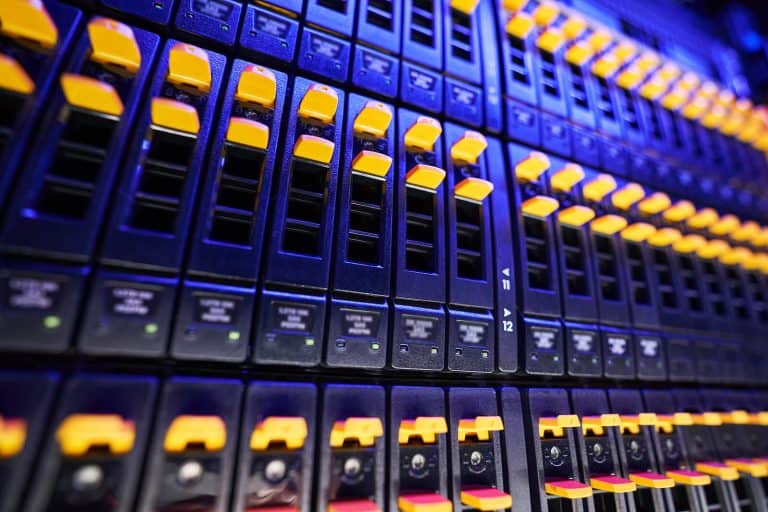What keeps your day job alive and Netflix-watching habits persistent if it weren’t for energy-intensive data centers? These monstrous tech warehouses have become necessary to keep critical infrastructure and households running smoothly. Perpetually connected operations are the ultimate goal of every tech company leveraging a data center’s power. However, they have become synonymous with high carbon emissions and steep costs to regulate their temperatures.
Table of Contents
ToggleIt’s possible to wrangle in the hot spots of your data center so it doesn’t impact the entire outfit. The goal is to get hot air to funnel into cooling systems for an infinite loop. More likely than not, there are only a few problem areas impacting efficiency and productivity, as opposed to needing to overhaul the entire building. Find the hot spots. Then, execute the top suggestions in the industry to send the data center on an Arctic holiday.
1. Use Liquid Cooling
Companies are realizing HVAC systems can’t do it all. Millions of dollars are funneling into alternative solutions like liquid cooling. HVACs need assistance with supplemental technologies to manage temperatures if they aren’t operating correctly or have an outage. Liquid cooling systems for servers are one of the most popular and practical solutions in the data center market. Combine with prefabricated modular data center (PMDC) solutions, and you could have the most agreeable temperatures in a data center’s history.
Legacy hardware uses a lot of power and emits great heat. Tech upgrades that make the hardware more consistent in size, performance capabilities, and scalability will increase the efficacy of liquid cooling systems in the center. If data center operators don’t want a complete liquid cooling setup, they can choose a hybrid air-liquid cooling design, which is also effective.
However, there is the possibility of too much of a good thing. Sometimes, hot spots in data centers occur because of excessive cooling because it encourages additional airflow, pushing the cool air around the servers away from them. These situations are easily avoidable with oversight.
Liquid cooling prevents overheating, which assists in a medley of other solutions to data centers that could allow enterprises to save money to continue finding temperature-regulating solutions. Many that switch to liquid cooling find it helps corporate social responsibility and sustainability objectives while increasing productivity and reducing downtime. These factors amount to happier customers and stakeholders — all because a company chose liquid cooling to manage the possibility of overheating.
2. Leverage Iot Sensors
Internet of Things (IoT) monitoring is almost ubiquitous now, but it’s as critical as ever for environmental management and data collection. Power this alongside AI and machine learning, and you have an unstoppable automation and data management combo.
Environmental quality IoT monitors can measure everything from air and water temperature to humidity indoors and outdoors. Any other facet of the data center you think could influence servers to overheat, you can view in centralized data hubs.
Air quality monitoring should be another consideration, as dust collection can foster stuffiness in a wire-packed tower. It could report to technicians if HVAC blockages appear. It might even be able to identify the root cause and halt operations until someone fixes it. Automating environmental condition notifications will make preventive maintenance a no-brainer, especially for a system expected to operate without ceasing. Here’s what it can notify mechanics of:
- Filter changes
- Efficiency drops or spikes
- Need for lubrication
- Part defects
- Changes in refrigerant levels
Alongside machine fault alerts and maintenance reminders, it can provide data scientists with information for more strategic sensor and tech placement. Are there monitors on top of racks where heat would naturally rise or near equipment intakes? The data may show the airflow isn’t balanced because some aisles remain more temperate than others. Data center managers could realign resources to distribute airflow for better consistent temperatures and prevent anomalies in data sourcing.
3. Watch for Biofilm
Biofilms are an issue in water treatment plants, but they can also be a nuisance for liquid cooling. Liquid is the perfect home for algae, fungi and bacteria which cause corrosion and buildup in precious liquid cooling towers. They proliferate in these contained areas faster than they would in open waters, creating thick mats of biofilm that disrupt water flow. These films can prevent the cooling effect from being as impactful on the machines, reducing efficiency significantly.
Legionella is the top concern among water management workers, as it can cause severe illness in the workforce. Data center oversight should maintain the same degree of precaution when cleaning, filtering and monitoring the data center’s liquid cooling and related water systems.
Regular maintenance and cleaning are vital to preventing bacterial growth. However, disinfectants and ultraviolet radiation aid in keeping water purified. Cooling systems could prioritize soft water, which includes fewer nutrients that bacterial metabolisms would want to reproduce.
4. Invest in Process Discovery
There are more obvious single purchases like new HVAC and tech that can make upgrades straightforward. However, long-term temperature regulation to prevent overheating in data centers requires more thoughtful process discovery. How can professionals discover and map the value of data center assets and translate that into an automated system that runs toward perfection?
It could be a few tech upgrades, or it might be more structural revelations like replacing windows. Here are some realizations management staff might uncover when examining the data center:
- Should more blanking panels stop hot air from impacting cool aisles?
- Are high-density servers evenly spaced out?
- How is rack airflow performance?
- Should old hardware get upgraded to more modern or modular solutions?
Only around 30% of cooler air goes to the correct spaces, making process discovery even more critical. Are there ways to contain heat or restrict unnecessary hot air from gaps or openings, and what can businesses do to quickly install management solutions?
5. Examine Floor Tiles
Many look above for overheating solutions because warm air rises. How can people tame that increasing heat? Looking below is an underrated solution for heat control because floor tiles can make or break the regulation. Raised floor tiles need smart positioning to distribute temperatures. Expert planners will even incorporate some tiles with no loads for optimal guidance in air direction.
Raised floor tiles may not be liquid cooling or HVAC systems that actively work to bring temperatures down, but raised floor tiles need as much care and attention as hardware does. Are there barriers that would prevent proper air circulation? Are tiles still sturdy and in position? These factors matter when encouraging cool air underneath boiling hardware.
Never Fear the Data Center Thermometer
Whether someone participates in a colocation data center or owns many, heating is an endless series of checks and balances. Using these strategies can reduce utility costs, save hours of maintenance and labor and keep minds calm that their precious energy and data stores will not be privy to an electrical fire.
Advancements continue to erupt from the innovative tech sector, as experts want to find every corner to optimize temperature control around these servers. Keep your eyes open for the next big tool because it could make operations even cooler.
FAQ
A: Preventing data center overheating is important because excessive heat can cause equipment failures, data loss, and downtime. It can also lead to increased energy consumption and operational costs. By maintaining optimal temperatures, organizations can ensure their data centre infrastructure’s reliability, efficiency, and longevity.
A: Data center overheating can be caused by inadequate cooling systems, poor airflow management, high server density, equipment malfunctions, and environmental factors like temperature fluctuations or improper facility design. These factors can lead to hotspots and temperature imbalances within the data center.
A: Some tips for preventing data center overheating include optimizing airflow management, ensuring proper ventilation and cooling system design, regularly monitoring and maintaining cooling infrastructure, implementing temperature and humidity monitoring systems, and considering energy-efficient cooling technologies like liquid cooling or containment solutions.
A: Airflow management can be improved by employing best practices such as arranging server racks in hot-aisle/cold-aisle configurations, sealing cable cutouts and openings, organizing cables to reduce obstructions, using blanking panels to fill empty rack spaces, and implementing hot/cold aisle containment strategies. These practices promote better air circulation and reduce the risk of hotspots.
A: Regular monitoring and maintenance are essential for data center cooling infrastructure to ensure optimal performance and identify potential issues. This includes inspecting and cleaning cooling equipment, checking for airflow blockages, monitoring temperature and humidity levels, and conducting periodic assessments to evaluate the effectiveness of cooling systems and make necessary adjustments or upgrades.




